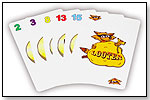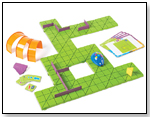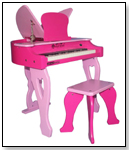|
|
Q & A With John Shelley, Creator of the Bag-O-Loot Card Game Patience and an Open Mind are the Key to Bringing Product to Market
Scroll to the bottom of the interview for the full, unedited version. 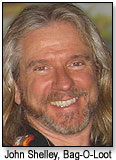 Q. What career path did you originally envision for yourself? Did you ever anticipate working with children’s products? Q. What career path did you originally envision for yourself? Did you ever anticipate working with children’s products?A. I’ve always been an inventor of things. I invented many different games as a child and even got my picture on the front page of the local paper when my best friend Josh and I built a “Trike,” a tricycle with a bench seat that could hold three kids. As for a career path, I’ve never had one. I have always just worked really hard at whatever I did. Q. How did you come up with the idea for your first product? A. My daughter, who was ten years old at the time, and I were sitting around at a ski lodge one night bored out of our minds. We were sick of all the usual games so we grabbed a couple decks of cards and just started making up rules as we went along. We came up with two of the fundamental elements of Bag-O-Loot: making sets of cards and stealing them from each other. Eventually we added the bluffing element which turned out to be the icing on the cake. Q. How long did it take to go from the original spark of an idea to actual production? A. After that night in the ski lodge, I jotted down the rules and set them aside with the idea that ‘someday’ I would make it a real game. Now that my daughter is in college I thought it would be a good time to bring it to market. I spent six months refining and testing the rules. I would try the game with different groups of people of all different ages, see what they thought, tweak the game, and go test it again. As the final rules began to solidify, I applied for a patent and trademark and started looking for a manufacturer. My wife Linda came up with the awesome idea of selling the cards in a little draw string bag which makes the packaging unique and functional – it’s great for travel. Q. How much money did you need to create the first prototype and come up with a business plan? A. We invested about fifty thousand dollars, which paid for the legal work and producing the first 5,000 decks. Q. How did you raise it, and how long did it take to raise it? A. We drained our bank account and borrowed some money from other family members. Q. How quickly did you spend your initial funds? Any regrets? A. We used up that money in about six months and have spent almost that much again since. Do I regret it? No, but I will be very happy the day we make that back and begin to turn a profit! Q. What were the top two or three best pieces of advice you received, and from whom? 1. Initially we were only going to sell the game on the internet. Then a friend of mine, John Little, offered to sell them in his convenience store in Sullivan, New Hampshire. We gave it a try and within four weeks he had sold almost two dozen decks. I think the population of Sullivan is only a few hundred people! This made me realize that having the game in stores where people could pick it up and look at it was the best way to sell it. 2. My wife told me last October to focus on sales and stop trying to develop other versions of the game. This helped me spend my energy more efficiently and have a tremendous first holiday season. 3. Recently I teamed up with the folks at S.C.O.R.E. and they are getting me to have specific marketing plans with specific goals and to stick to them. This is helping me measure what is the best way to market Bag-O-Loot. Q. The worst two or three pieces of advice? A. Do I have to answer this one? I think I am my own worst enemy…There was the idea I had to mail out a free game to every single fire station in New England. That cost thousands of dollars, produced only one sale, and we did not get a single thank you. Then there was the day I stood in the middle of an intersection wearing a sandwich board trying to hand out flyers to people stopped at the stop light… Boy, did I get a bunch of funny looks that day…Then we tried to make a costume to wear in a Christmas parade - a big gold box that was supposed to look like a Bag-O-Loot. We cut out eye holes but forgot to cut out holes for our arms, so we could hardly see, could barely breath, and kept bumping into things! Q. What were the top two or three most significant obstacles you had to overcome to achieve success and how did you do it? 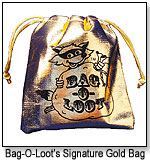 A. Deciding how to market Bag-O-Loot was the most important thing we had to figure out. Our shiny gold bag is a great attention getter, and when piled high in the floor display, it looks like a heap of gold bricks. At Christmas, they were flying out the doors. The other obstacle, which is ongoing, is how to get the word out to more people and more stores about how great the game really is. We have a very limited advertising budget, and those dollars must be spent wisely. A. Deciding how to market Bag-O-Loot was the most important thing we had to figure out. Our shiny gold bag is a great attention getter, and when piled high in the floor display, it looks like a heap of gold bricks. At Christmas, they were flying out the doors. The other obstacle, which is ongoing, is how to get the word out to more people and more stores about how great the game really is. We have a very limited advertising budget, and those dollars must be spent wisely.Q. What one unique quality makes your product better than your competition? A. Bag-O-Loot is just as engaging and fun for adults to play as it is for kids. We can never stress this point enough when telling people about the game. Kids eight and older understand the game as well as adults so you don’t have to ‘dumb down’ the game to play with them. Conversely, the game is not so simple it is boring to play as an adult or group of adults. It invokes all types of emotions; all players are constantly interacting; and there are many different strategies you can use. Q. What were your total sales during your first year? A. We had about $15,000 in sales our first year. In the first six months of our second year we have already matched that. We expect to sell over 30,000 units this year. Q. What aspect of the toy industry most surprised you when you first started? A. I think the biggest eye opener was when we went to the New York International Toy Fair in February. To see a conference center that large covered wall to wall in toys really said two things. First, it is obviously a huge and healthy industry and second, there is a ton of competition. It became obvious it takes more than just a great game to succeed in this business. Q. How do you hope your product/s will affect children's lives? 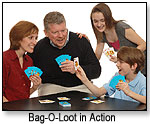 A. In this age of electronic games, people – kids especially – are losing the ability to socialize face to face. This is not healthy for them or for society as a whole. Getting kids and families playing together would be our greatest gift to the world. Because Bag-O-Loot is appealing to such a wide range of ages, we think we have a great chance at succeeding. A. In this age of electronic games, people – kids especially – are losing the ability to socialize face to face. This is not healthy for them or for society as a whole. Getting kids and families playing together would be our greatest gift to the world. Because Bag-O-Loot is appealing to such a wide range of ages, we think we have a great chance at succeeding.Q. What hardships did you have to overcome during your formative years and how did they help you persevere as a business owner? A. This is a great question. The toughest hardships of starting this business was dealing with the doubts, fears, and worries my family had to endure. One of the main differences with Bag-O-Loot compared to many of the other companies I’ve started was the amount of money I had to invest up front. Every time I wrote out another big check, my wife would cringe. What I had to overcome personally was the urge to give up. I had to stay committed to the goal and never lose sight of what I was doing. Q. What is the most disappointing thing that you have to live with as a business owner? A. Um, NOT becoming a millionaire overnight? Q. What one piece of advice would you offer to someone just starting out in the toy industry? A. Don’t be in a hurry to sell a zillion games. There is a lot of competition out there, and a lot of other fun, new games coming out all the time. Take your time, have a business plan, and get lots of advice. Scroll to the bottom of the article to see a product description of Bag-O-Loot. Unedited Interview: 1. What career path did you originally envision for yourself? Did you ever anticipate working with children’s products? I’ve always been an inventor of things. I invented many different games as a child and even got my picture on the front page of the local paper when my best friend Josh and I built a “Trike.” (A tricycle with a bench seat that could hold three kids.) As for a career path, I’ve never had one. I have always just worked really hard at whatever I did. Making Bag-O-Loot is a ton of work, but it brings so many smiles and laughs to people it is all worth it. 2. How did you come up with the idea for your first product? My daughter, who was ten years old at the time, and I were sitting around at a ski lodge one night bored out of our minds. We were sick of all the usual games so we grabbed a couple decks of cards and just started making up rules as we went along. We came up with two of the fundamental elements of Bag-O-Loot: making sets of cards and stealing them from each other. Eventually we added the bluffing element which turned out to be the icing on the cake. 3. How long did it take to go from the original spark of an idea to actual production? After that night in the ski lodge, I jotted down the rules and set them aside with the idea that ‘someday’ I would make it a real game. Well, now that my daughter is in college I thought it would be a good time to bring it to market. I spent six months refining and testing the rules. I would try the game with different groups of people of all different ages, see what they thought, tweak the game, and go test it again. As the final rules began to solidify, I applied for a patent and trademark and started looking for a manufacturer. My wife Linda came up with the awesome idea of selling the cards in a little draw string bag which makes the packaging unique and functional – it’s great for travel. 4. How much money did you need to create the first prototype and come up with a business plan? We invested about fifty thousand dollars, which paid for the legal work and producing the first 5,000 decks. 5. How did you raise it, and how long did it take to raise it? We drained our bank account and borrowed some money from other family members. 6. How quickly did you spend your initial funds? Any regrets? We use up that money in about six months and have spend almost that much again since. Do I regret it? No, but I will be very happy the day we make that back and begin to turn a profit! 7. What were the top two or three best pieces of advice you received and from who? 1. Initially we were only going to sell the game on the internet. Then a friend of mine, John Little, offered to sell them in his convenience store in Sullivan, New Hampshire. We gave it a try and within four weeks he had sold almost two dozen decks. I think the population of Sullivan is only a few hundred people! This made me realize that having the game in stores where people could pick it up and look at it was the best way to sell it. 2. My wife told me last October to focus on sales and stop trying to develop other versions of the game. This helped me spend my energy more efficiently and have a tremendous first holiday season. 3. Recently I teamed up with the folks at S.C.O.R.E. and they are getting me to have specific marketing plans with specific goals and to stick to them. This is helping me measure what is the best way to market Bag-O-Loot. 8. The worst two or three pieces of advice (feel free to mention who gave them to you)? Really? Do I have to answer this one? I think I am my own worst enemy. *LOL* Let’s see. There was the idea I had to mail out a free game to every single fire station in New England. That cost thousands of dollars, produced only one sale, and we did not get a single thank you. Then there was the day I stood in the middle of an intersection wearing a sandwich board trying to hand out flyers to people stopped at the stop light… Boy, did I get a bunch of funny looks that day. Oh yeah, then we tried to make a costume to wear in a Christmas parade. A big gold box that was supposed to look like a Bag-O-Loot. We cut out eye holes but forgot to cut out holes for our arms, so we could hardly see, could barely breath, and kept bumping into things! 9. What were the top two or three most significant obstacles you had to overcome to achieve success and how did you do it? Deciding how to market Bag-O-Loot was the most important thing we had to figure out. Our shiny gold bag is a great attention getter, and when piled high in the floor display, it looks like a heap of gold bricks. At Christmas, they were flying out the doors. The other obstacle, which is ongoing, is how to get the word out to more people and more stores about how great the game really is. We have a very limited advertizing budget, and those dollars must be spent wisely. 10. What one unique quality makes your product better than your competition? Bag-O-Loot is just as engaging and fun for adults to play as it is for kids. We can never stress this point enough when telling people about the game. Kids eight and older understand the game as well as adults so you don’t have to ‘dumb down’ the game to play with them. Conversely, the game is not so simple it is boring to play as an adult or group of adults. It invokes all types of emotions; all players are constantly interacting; and there are many different strategies you can use. Every round is different, and you always want to play again. As my great niece just said a couple days ago, “It’s even fun when you lose!” 11. What one piece of advice would you offer to someone just starting out in the toy industry? Don’t be in a hurry to sell a zillion games. There is a lot of competition out there, and a lot of other fun new games coming out all the time. Take your time, have a business plan, and get lots of advice. 12. What were you total sales during your first year? Feel free to share the sales totals for your second year as well. We had about $15,000 in sales our first year. In the first six months of our second year we have already matched that. We expect to sell over 30,000 units this year. 13. What aspect of the toy industry most surprised you when you first started? I think the biggest eye opener was when we went to the New York City Toy Fair in February. To see a conference center that large with wall to wall toys it really said two things. First, it is obviously a huge and healthy industry and second, there is a ton of competition. It became obvious it takes more than just a great game to succeed in this business. 14. How do you hope your product/s will affect children's lives? In this age of electronic games, people – kids especially – are losing the ability to socialize face to face. This is not healthy for them or for society as a whole. Getting kids and families playing together would be our greatest gift to the world. Because Bag-O-Loot is appealing to such a wide range of ages we think we have a great chance at succeeding. 15. Where do you think the industry is headed? With the economy the way it is, people will be on the lookout for new ways to have fun that don’t cost hundreds of dollars. For the next few years I suspect card games and board games to see strong sales. 16. Where and what did you study? My training and skills come from 30+ years of starting and running many different businesses. By trade I am a software developer. 17. Where did you grow up? I was born in New Jersey, but I grew up in New Hampshire, and I’ve lived here all my adult life. 18. What hardships did you have to overcome during your formative years and how did they help you persevere as a business owner? This is a great question. The toughest hardships of starting this business was dealing with the doubts, fears, and worries my family had to endure. One of the main differences with Bag-O-Loot compared to many of the other companies I started was the amount of money I had to invest up front. Every time I wrote out another big check, my wife would cringe. What I had to overcome personally was the urge to give up. I had to stay committed to the goal and never lose sight of what I was doing. 19. What is the most disappointing thing that you have to live with as a business owner? Um, NOT becoming a millionaire overnight? 20. If you had to start over, what would you do differently? I would follow my own advice I gave earlier. Take it slower and get lots of advice. I might have avoided a few mistakes and saved a few dollars along the way.
 Writer's Bio: Justina Huddleston graduated Magna Cum Laude from Emerson College with a BA in Writing, Literature, and Publishing in 2009. After graduating she was the on-site director of the Boston Children's Museum gift store for a year, selling educational, developmental, and creative activity toys that tied in with the museum's exhibits. Justina also interned at children's book publisher Candlewick Press before moving from Boston to Los Angeles, where she is now Editorial Director of TDmonthly Magazine. Read more articles by this author Writer's Bio: Justina Huddleston graduated Magna Cum Laude from Emerson College with a BA in Writing, Literature, and Publishing in 2009. After graduating she was the on-site director of the Boston Children's Museum gift store for a year, selling educational, developmental, and creative activity toys that tied in with the museum's exhibits. Justina also interned at children's book publisher Candlewick Press before moving from Boston to Los Angeles, where she is now Editorial Director of TDmonthly Magazine. Read more articles by this author |
| ||||||||||||||||||||||||||||||||||||||
Disclaimer Privacy Policy Career Opportunities
Use of this site constitutes acceptance of our Terms of Use.
© Copyright 2025 PlayZak®, a division of ToyDirectory.com®, Inc.

